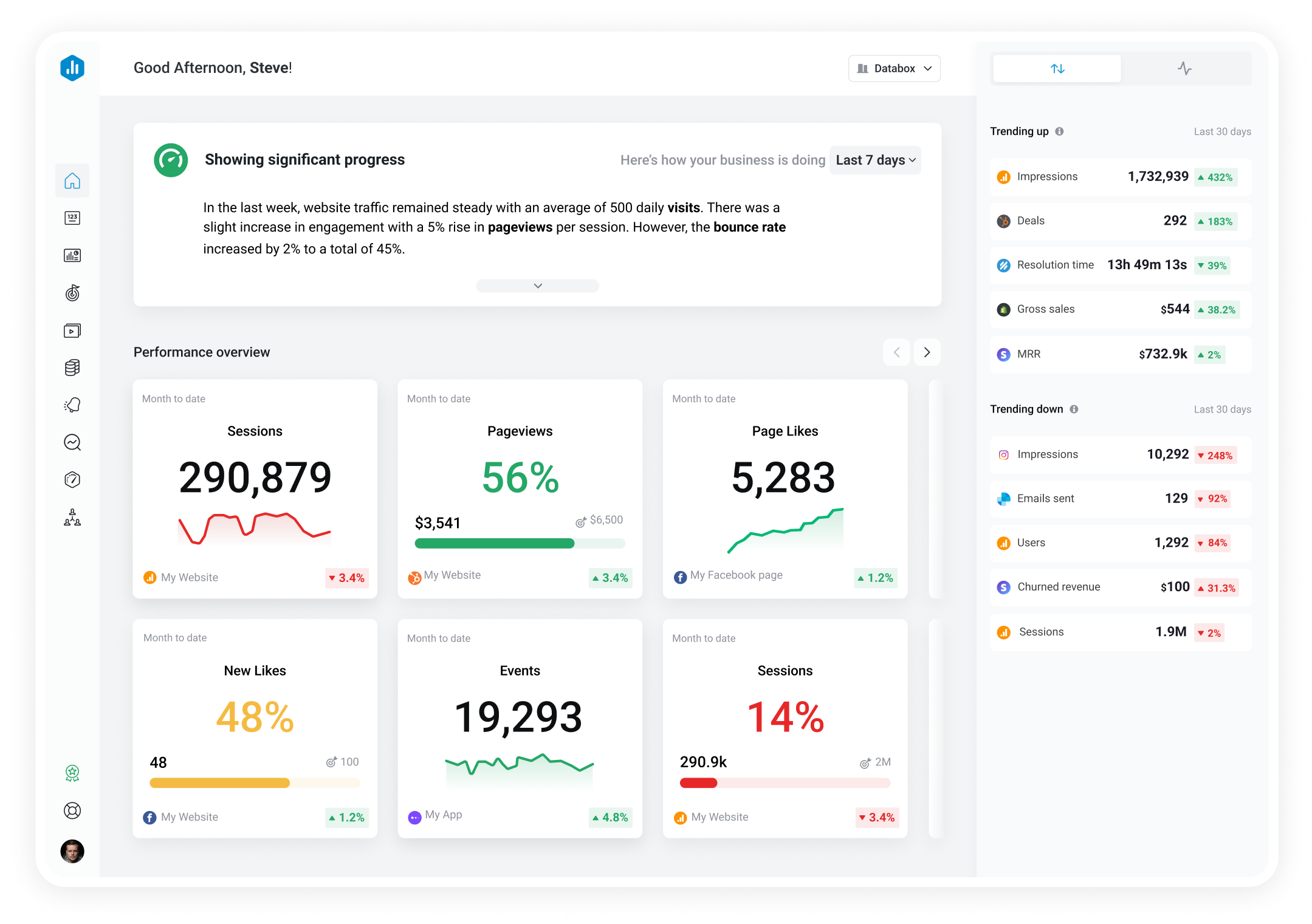Track all of your key business metrics from one screen
GET STARTED
 Google Analytics 4
Engagement Rate
Google Analytics 4
Engagement Rate Engagement Rate is a metric that measures how users interact with your website or app. It captures the percentage of sessions in which users engaged with your site, such as clicking on a link, watching a video or scrolling through content.
With Databox you can track all your metrics from various data sources in one place.
Engagement refers to the level of interaction, involvement, and interest that users exhibit when interacting with a website, application, or digital content. It encompasses various actions, such as clicks, likes, shares, comments, and time spent on a page.
For example, you can measure the level of interaction and response that a LinkedIn Ad receives from its target audience. The metric takes into account the actions taken by viewers such as clicks, likes, comments, shares, and follows, and a higher rate indicates that the ad is resonating with the target audience, which can lead to increased awareness, lead generation, and ultimately, conversions.
Measuring engagement helps businesses assess the effectiveness of their digital strategies because they can evaluate different types of content to determine what works best for their audiences.
Engagement is typically calculated as a percentage or ratio, representing the number of engaged actions or interactions divided by the total number of users or sessions.
The formula is the following: Engagement (%) = (Number of engaged actions / Total number of users or sessions) x 100
Here’s an example for a social media post. The post receives 300 likes, 50 comments, and 20 shares. The total number of impressions is 5,000.
Step one would be to add up all engaged actions:
Total engagement = Likes + comments + shares
Total engagement = 300 + 50 + 20 = 370
Step two is to calculate the engagement rate:
Engagement rate (%) = (Total engaged actions / Total impressions) x 100
Engagement rate (%) = (370 / 5,000) x 100 = 7.4%
A good engagement rate varies based on the industry, platform, and type of content. Higher engagement rates generally indicate a more responsive and interested audience.
Our benchmark data shows the following:
Want to compare more data for even deeper insights into your performance? Join our Benchmark Groups to keep up with future trends—it’s anonymous and free for everyone!
Improving engagement is crucial for increasing user satisfaction and achieving business goals. Here are a few tested strategies to boost engagement:
More resources to help you improve:

Used to show a simple Metric or to draw attention to one key number.

Used to illustrate numerical proportions through the size of the slices.

Used to show comparisons between values.
Databox is a business analytics software that allows you to track and visualize your most important metrics from any data source in one centralized platform.
To track Engagement Rate using Databox, follow these steps:
 Goals
Goals Scorecards
Scorecards Metric Digest
Metric Digest Metric Builder
Metric Builder Data Calculations
Data Calculations Performance Screen
Performance ScreenFocus in on the metrics that matter from your Google Analytics 4 account. Measure the key outcomes that your website was designed to create, as well as the leading indicators that help pinpoint where your greatest opportunities lie.


Use this Google Analytics 4 report to analyze and share insights into website engagement, audience behavior, and content marketing efforts.

An example of an engagement metric is likes, comments, or shares on a social media post. However, if we’re speaking about website content, metrics like bounce rate, average time on page, and scroll depth also measure engagement, as well as conversion rate or pageviews on a landing page.
You can analyze engagement metrics by creating a strategy and setting goals, then choosing the appropriate tools, like Databox, to track and analyze the numbers. Analyze engagement metrics in combination with other relevant metrics you’re tracking, such as conversion rates, and try to determine if higher engagement led to more conversions. Conduct A/B tests to pinpoint exactly what kind of content resonates with your audience.
You typically count engagement metrics by using tracking tools like Google Analytics or social media analytics. These tools measure user interactions, such as clicks, shares, and comments, and provide data on user behavior and engagement levels.
